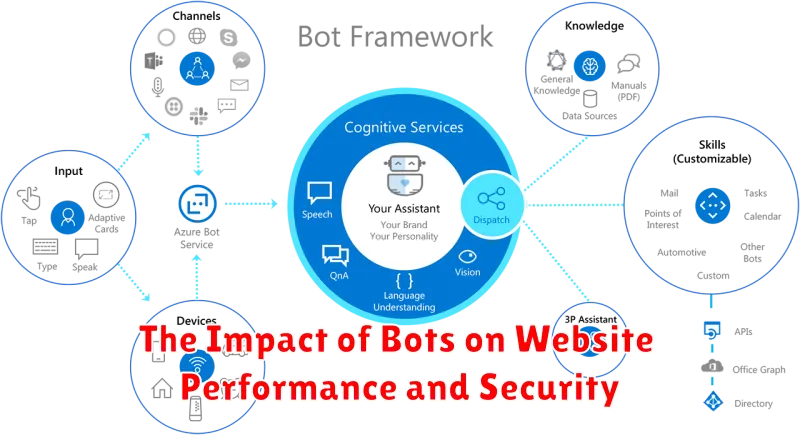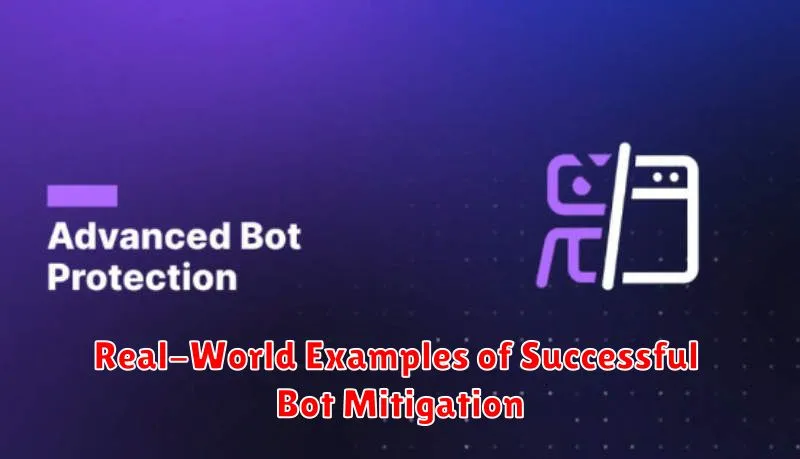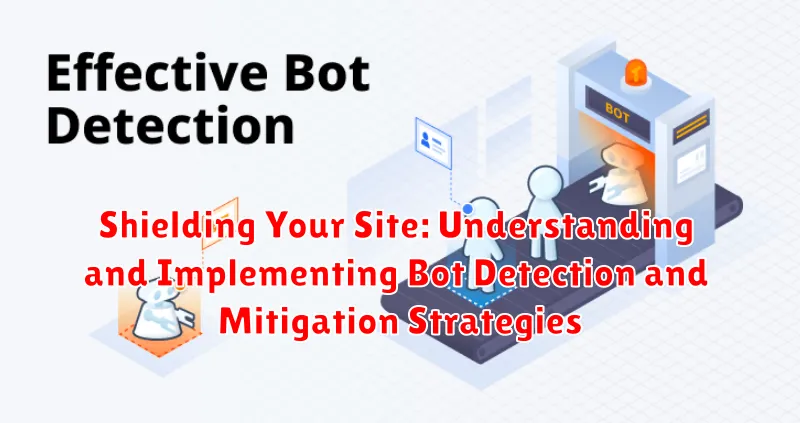In today’s dynamic digital landscape, website security is paramount. A significant threat to online businesses and individual websites alike is the pervasive presence of malicious bots. These automated programs, often disguised as legitimate users, can engage in a variety of harmful activities, from content scraping and spam submissions to credential stuffing and DDoS attacks. Understanding the risks posed by these bots and implementing robust bot detection and mitigation strategies are crucial for maintaining the integrity, performance, and security of your online presence. Protecting your site is not just about defense; it’s about ensuring a positive user experience for genuine visitors and safeguarding your valuable resources.
This article serves as a comprehensive guide to shielding your site from the detrimental effects of bot activity. We will delve into the intricacies of bot detection techniques, exploring various methods from basic CAPTCHAs to advanced behavioral analysis and machine learning algorithms. Furthermore, we will outline effective mitigation strategies that can be implemented to neutralize the threat posed by bots, minimizing their impact on your website’s resources and performance. By equipping you with the knowledge and tools to effectively identify and combat bots, we aim to empower you to create a safer and more secure online environment for your users and your business.
What Are Bots and Why Are They a Threat?
Bots, short for robots, are automated software applications designed to perform specific tasks over the internet. While some bots serve legitimate purposes, such as search engine crawlers or customer service chatbots, a significant portion engages in malicious activities that can severely impact website performance and security.
These malicious bots can be used for a variety of nefarious purposes, including web scraping, credential stuffing, distributed denial-of-service (DDoS) attacks, and spamming. They can consume significant bandwidth, leading to slower loading times and a degraded user experience. Furthermore, bots can compromise sensitive data, damage your website’s reputation, and even lead to financial losses.
Therefore, understanding what bots are and the threats they pose is the first crucial step in implementing effective bot detection and mitigation strategies to protect your online assets.
Understanding the Different Types of Malicious Bots
Malicious bots come in various forms, each designed for specific nefarious purposes. Understanding these types is crucial for effective bot detection and mitigation.
Common Types of Malicious Bots:
- Scrapers: These bots extract content from websites, often without permission, potentially leading to copyright infringement or unfair competition.
- Spambots: Designed to post spam content on forums, comment sections, and other online platforms, these bots can damage a website’s reputation and user experience.
- Credential Stuffing Bots: These bots use lists of stolen usernames and passwords to attempt to gain unauthorized access to user accounts.
- Denial-of-Service (DoS) Bots: These bots flood a website with traffic, overwhelming its resources and making it unavailable to legitimate users.
- Click Fraud Bots: These bots generate fake clicks on online advertisements, wasting advertising budgets and skewing marketing analytics.
Identifying the specific type of bot targeting your website is essential for implementing the most effective countermeasures. Each type operates differently and requires a tailored approach for successful mitigation.
The Impact of Bots on Website Performance and Security

Malicious bots can significantly degrade website performance and compromise security. These automated programs consume bandwidth, overload servers, and negatively impact user experience by slowing down page load times and potentially causing website downtime.
From a security standpoint, bots are often employed to carry out various nefarious activities. These activities include, but are not limited to: credential stuffing, scraping sensitive data (pricing, content, etc.), form spamming, and Distributed Denial-of-Service (DDoS) attacks. Such attacks not only disrupt service availability but can also lead to data breaches, reputational damage, and financial losses.
Furthermore, bots can distort website analytics, making it difficult to accurately gauge genuine user behavior and marketing campaign effectiveness. Properly identifying and mitigating bot traffic is crucial for maintaining a healthy and secure online presence.
Key Bot Detection Techniques: Identifying Suspicious Activity
Identifying bots requires a multi-faceted approach, leveraging various techniques to analyze traffic patterns and user behavior. These methods often combine to provide a more accurate assessment.
Common Detection Methods
- Rate Limiting: Monitoring the frequency of requests from a specific IP address or user. An unusually high rate suggests bot activity.
- CAPTCHAs: Presenting challenges that are easy for humans to solve but difficult for bots, such as identifying distorted text or images.
- Honeypots: Creating decoy links or fields that are invisible to humans but attractive to bots. Bot interaction with these elements indicates malicious intent.
- User Agent Analysis: Examining the user agent string sent by the browser or application. Bots often use generic or outdated user agents.
- Behavioral Analysis: Tracking user interactions on the website, such as mouse movements, typing speed, and scrolling patterns. Deviations from typical human behavior can flag bots.
- JavaScript Challenges: Requiring the execution of JavaScript code to verify a user’s browser environment. Bots may struggle to execute JavaScript correctly.
Effective bot detection relies on continuously monitoring and adapting these techniques to stay ahead of evolving bot technology.
Effective Bot Mitigation Strategies: Blocking and Managing Bots
Once malicious bots are detected, implementing effective mitigation strategies is crucial. These strategies aim to block or manage bot traffic without impacting legitimate users.
Common Mitigation Techniques
Rate limiting restricts the number of requests from a single IP address within a specific timeframe, preventing bots from overwhelming the server. CAPTCHAs challenge users with tasks that are easy for humans but difficult for bots to solve. IP blocking blacklists IP addresses associated with known bot networks. Geo-fencing restricts access based on geographical location.
Managing Bot Access
Instead of outright blocking, consider alternative approaches for some bots. Deceptive techniques, such as honeypots, can lure bots into traps, revealing their malicious intent. Challenge pages can require bots to execute JavaScript or solve puzzles before granting access, increasing the cost of bot operations. Progressive challenges allows escalating the difficulty of challenges for suspicious requests, for example displaying CAPTCHA.
Selecting the appropriate mitigation strategy depends on the type of bot, the potential impact, and the desired level of user experience. A layered approach, combining multiple techniques, provides the most robust defense.
Implementing a Bot Management Solution: Choosing the Right Tools
Selecting the appropriate bot management solution is crucial for effective bot mitigation. A range of tools are available, each with varying features and capabilities. Consider your specific needs and the scale of your website when making your selection.
Key considerations include:
- Accuracy: The tool’s ability to distinguish between legitimate users and malicious bots is paramount.
- Scalability: The solution should be able to handle increasing traffic volumes without impacting website performance.
- Customization: Look for solutions that allow you to tailor rules and policies to your specific requirements.
- Reporting and Analytics: Robust reporting features provide valuable insights into bot activity and the effectiveness of mitigation strategies.
- Integration: Ensure the solution integrates seamlessly with your existing infrastructure.
Options range from simple, rule-based systems to sophisticated solutions leveraging machine learning. Cloud-based solutions often offer ease of deployment and scalability, while on-premise solutions provide greater control over data and infrastructure. Evaluate the total cost of ownership, including implementation, maintenance, and ongoing support, before making a decision.
Best Practices for Maintaining a Bot-Free Environment
Maintaining a bot-free environment is an ongoing process that requires vigilance and proactive measures. It’s not a one-time fix but a continuous effort to protect your website.
Regularly review your bot management solution’s settings and update them as needed. Bot behavior evolves, and your defenses must adapt accordingly. This includes adjusting thresholds, whitelists, and blacklists based on observed traffic patterns.
Actively monitor your website’s traffic for anomalies. Look for sudden spikes in requests, unusual user agent strings, or other suspicious activities. Utilize analytics tools to track key metrics and identify potential bot-related issues.
Implement a web application firewall (WAF) to provide an additional layer of security. A WAF can help block malicious bot traffic before it reaches your servers.
Educate your team about the latest bot threats and mitigation techniques. A well-informed team is better equipped to identify and respond to bot-related incidents.
Consistently audit your security logs for any indication of bot activity. This can help you identify patterns and improve your bot detection and mitigation strategies.
The Role of Machine Learning in Advanced Bot Detection
Machine learning (ML) has revolutionized bot detection by offering more sophisticated and adaptive solutions than traditional rule-based methods. ML algorithms can analyze vast amounts of data to identify subtle patterns and anomalies indicative of bot activity.
Benefits of Machine Learning in Bot Detection
Using machine learning models provides several key advantages:
- Adaptability: ML models can learn and adapt to evolving bot tactics, staying ahead of new threats.
- Accuracy: By analyzing multiple features, ML can significantly reduce false positives and false negatives, ensuring legitimate users aren’t mistakenly blocked.
- Automation: ML can automate the detection process, reducing the need for manual intervention and freeing up security personnel.
These models analyze data points such as user behavior, request patterns, and IP reputation to accurately distinguish between human and bot traffic, even when bots employ sophisticated cloaking techniques. The continuous learning capability ensures ongoing effectiveness against new and evolving bot threats.
Real-World Examples of Successful Bot Mitigation

This section highlights several instances where bot mitigation strategies have proven highly effective in safeguarding websites and online services. These examples demonstrate the tangible benefits of proactive bot management.
E-commerce Site Protecting Against Credential Stuffing
A major e-commerce retailer implemented a sophisticated bot detection system that identified and blocked a large-scale credential stuffing attack. This prevented unauthorized access to customer accounts and protected sensitive data, resulting in increased customer trust and reduced fraud losses. Key was the system’s ability to analyze login patterns and flag anomalous behavior.
Media Company Combating Content Scraping
A prominent news organization experienced rampant content scraping, impacting their SEO rankings and advertising revenue. By deploying a bot management solution with advanced fingerprinting capabilities, they were able to identify and block malicious scrapers, leading to a significant improvement in website performance and a boost in organic traffic. The solution focused on blocking headless browsers and API abuse.
Online Gaming Platform Preventing DDoS Attacks
An online gaming platform suffered from frequent Distributed Denial of Service (DDoS) attacks launched by botnets. After implementing a cloud-based bot mitigation service, they successfully neutralized these attacks, ensuring uninterrupted gameplay for their users and preventing significant financial losses. Rate limiting and traffic shaping were crucial in mitigating the impact.
Staying Ahead of the Curve: The Future of Bot Detection and Mitigation
The landscape of bot technology is constantly evolving, demanding a proactive and adaptive approach to detection and mitigation. Staying ahead requires a commitment to understanding emerging bot techniques and implementing cutting-edge solutions.
Anticipating Future Bot Threats
Future bot attacks will likely leverage increasingly sophisticated methods, including:
- Advanced AI-powered bots: Bots that learn and adapt their behavior to evade detection.
- Decentralized botnets: Botnets that are more difficult to track and dismantle.
- Evasion techniques: Sophisticated methods to mimic human behavior more convincingly.
The Evolution of Mitigation Strategies
To counter these threats, future mitigation strategies will focus on:
- Enhanced machine learning: More accurate and nuanced bot detection models.
- Behavioral analysis: Deeper understanding of user behavior to identify anomalies.
- Real-time adaptation: Systems that can automatically adjust mitigation strategies in response to evolving bot behavior.
Continuous monitoring, ongoing research, and a willingness to adapt are crucial for maintaining a robust defense against evolving bot threats. Organizations must invest in resources and expertise to ensure they remain one step ahead.

